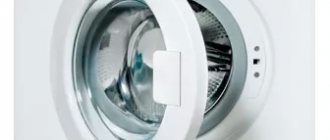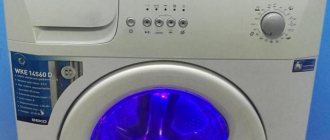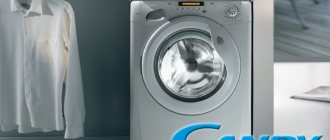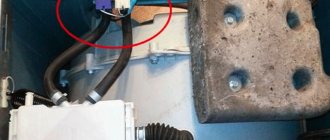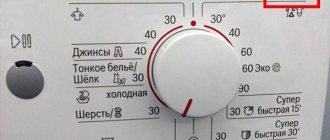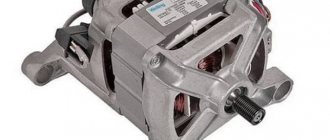When a washing machine does not wash well, this becomes a signal that the machine is faulty. There can be many reasons: from low-quality powder to technical problems. Some of them can be fixed on your own.
offers inexpensive, home-based repairs of washing machines. You can submit an application using the online application on the website or by phone number. Our employees work with equipment of all brands: AEG, Ariston, Whirlpool, Bosch, Hansa, Miele, Samsung, LG, Indesit, Candy, Ardo, Zanussi, etc. Repairs and replacement parts are guaranteed.
Causes of malfunction
Our experts have prepared a list of the most common reasons why a washing machine does not wash clothes well.
Wrong mode selected
Things remained dirty after the cycle ended.
Set a program that works well for your specific fabric type. On many things, manufacturers themselves indicate which mode is required (on the tags).
Economical consumption
This problem is more often encountered by users who purchased budget models. Such washing machines strive to save everything: powder, water. As a result, the fabric does not wash well.
The main symptom is white stains from the powder (the device saves rinsing liquid and does not rinse out the cleaning agent well).
If the owner does not plan to purchase a new device, there is only one way out - to load less laundry.
Overload
Stains remain on clothes and holes appear.
Due to the tight fit, things rub against each other. As a result, even new underwear remains scuffed.
Try not to load the machine to the maximum: in the instructions, the manufacturer indicates the permissible amount of laundry. Exceeding will result in damage.
Bad powder
It is worth noting that this is the most common source of the problem. Cheap gels and other cleaning agents will save money, but will not guarantee stain removal. In addition, they damage clothes: they fade, stretch and tear.
Buy cleaning products that have been tested or recommended by the manufacturer.
Dirty water
Traces of rust remain on the material, and the powder does not foam well.
If the source is a hard liquid, purchase special emollients from household chemical stores. An analogue is soda, just pour 1-2 spoons into the drum.
If the problem is an old plumbing system, contact your utility company.
Clothes are very dirty
If there are stains that are difficult to remove (fuel oil, oil, etc.), they may remain after washing. Even good stain removal products won't help.
If possible, set the maximum temperature - 90-95 degrees, this will enhance the effect of the powder. Important: before starting a cycle, make sure that this mode will not damage your laundry.
Also, before loading, rub the most contaminated areas with laundry soap.
Dirt inside the drum
After washing, the laundry turns out to be dirtier than before. Some things may smell unpleasant (musty). The reason is poor maintenance of the unit, as a result of which mold or other microorganisms appear.
Follow the operating instructions and care for the device.
- Rinse the tray, carefully removing any remaining detergent.
- Clean the water inlet hose.
- Periodically run an “empty cycle”: set the temperature to high and add special compounds to prevent contamination (they can be purchased in specialized stores).
- After each cycle, remove any remaining moisture with a dry cloth (pay special attention to the tray and cuff).
Broken heating element
The entire cycle takes place in cold water. This is easy to check: just touch the glass of the hatch 20 minutes after starting work at high temperature. If the glass is cold, you need to call a specialist to check the heating element.
It usually fails due to:
- scale formation;
- frequent power surges in the network.
Experts recommend changing the heating element every 5-6 years.
In case of minor breakdowns, the engineer repairs the heating element. But usually it changes to a new one.
Bearing failure
Traces of grease remain on clothing. Also, with such a problem, the rotation speed of the tank slows down.
The problem arises as a result of natural wear of parts during long-term use or due to mechanical damage.
Replacing failed bearings will help eliminate the defect.
Loose drum belt
The tank begins to rotate more slowly until at one point it stops completely.
It is impossible to restore the belt to its previous condition, so the technician replaces it with a new one.
All sources due to which clothes cannot be washed in a washing machine can be divided into two groups:
- user errors and improper care of the device;
- technical issues.
Most can be repaired yourself. But to troubleshoot problems that require intervention in the design, we recommend calling a service engineer.
The washing machine does not wash clothes well: reasons
Household appliances perform their functions poorly in the following cases:
- improper installation and operation;
- manufacturing defects;
- natural wear and tear.
Any device needs to be monitored and looked after. Since the washing machine works with water and chemicals, it is necessary to clean it, as well as provide it with consumables - that is, water and washing powder - of proper quality. No equipment is immune from natural wear and tear; over time, it wears out its useful life. But if you take care of the unit and use it taking into account the manufacturer’s recommendations, it will last longer without problems. Then the question will not arise why the washing machine does not wash things.
Wrong choice of powder
Sometimes the problem turns out to be not in the equipment, but in the detergent. It may turn out to be of low quality, cheap, or a counterfeit of a more expensive one. Such powders and gels do not remove dirt, leave stains and streaks on things, and make clothes gray and dull.
To understand that this is the reason, you need to thoroughly wash the tray and wash it with another SMS. The difference can be amazing.
In addition to the composition, it is important to monitor the dose. If you use less, the clothes will not wash properly. And if you exceed the dose, then during the standard cycle the machine will not be able to rinse it completely. This will result in dirty and soapy stains.
Water
If the machine does not wash properly, the quality or purity of the water may have changed. Perhaps the filter has expired, an accident has occurred, or pipes have been replaced on a common pipeline. In such cases, the water becomes rusty and may contain foreign matter and even dirt. This leads to stains and poor wash quality.
The problem can be solved by installing or replacing a dirt filter.
It is also necessary to take into account the hardness of the water. In soft water, detergents dissolve better, but in hard water they may not foam or wash at all. If your water is hard, you need detergents specifically for hard water or additional softeners. If you replace granular powder with liquid or regular grated laundry soap, they can work more effectively in hard water. You can find out the hardness by sending the water to a laboratory or using special test strips.
Wrong mode
Modern appliances provide an increased selection of washing programs. Economical modes are very common, which help refresh laundry rather than clean it of serious dirt.
Perhaps you chose insufficient temperature, washing and rinsing time, or loaded too much volume. Programs for cotton, for example, are more intense and longer than for synthetics. Perhaps you do not sort things, but load everything into the drum together, including the shortest program at a low temperature. This will, of course, make things seem fresher, but over time this leads to a deterioration in their appearance and poor condition. This is especially true for white and light-colored objects.
Too economical consumption
This reason is related to the previous one. In order to save money, some housewives use little or no powder at all, and also set a program that minimizes time and water consumption. The machine still cannot wash in cold water, quickly and without powder. The lack of economical consumption and contaminants not being washed off is more common with inexpensive models. If stains remain on your clothes, there is only one way out - load less laundry into the drum. You can also set an additional rinse program.
Overload
Each device is designed for a certain weight and volume. If you exceed it, things will not be distributed evenly throughout the drum and will not be completely saturated with water and detergent. The laundry will adhere too tightly to other items and to the inner surface of the tank. This will result in tears in the fabric, holes, and an overall washed out appearance.
Dirt inside the drum
If the washing machine begins to wash poorly, and additional stains appear on things, perhaps the reason is that dirt gets into the drum from the outside. This could be mold that accumulates inside the drum, as well as on and under the rubber seal on the hatch. It can also be lime and mud deposits on the heating element, which fall off and get inside.
To prevent such a malfunction from occurring, you need to clean the heating element using special compounds or citric acid. The seal on the hatch also needs to be cleaned regularly. You can run an idle washing cycle without laundry, but with detergents and heating up to 90 degrees.
Unit failure
If the machine does not wash properly, it may be broken.
The three most likely failures:
- There is a malfunction of the heating element, in which it does not heat the water; washing occurs in cold water. Sometimes the heating element itself is working, but the electronics that control it are faulty. In this case, repair of washing machine circuit boards is necessary.
- Drive belt stretch. The drum does not rotate or does not move as required by the program. In this case, replacing the belt will help.
- Wear and abrasion of bearings. They need to be replaced with new ones.
You can notice signs of damage yourself. If the door remains cold, if the tub rotates slowly or does not rotate at all, if the unit is noisy or a grinding sound is heard, diagnostics and repair of the washing machine is necessary. Repairing or replacing individual parts is not that expensive. But this will extend the service life by several years and improve the quality of washing.
DIY repair
The user can eliminate defects not related to the technical condition with his own hands.
- Set the correct program to suit your clothing.
- Choose a good detergent (recommended by the manufacturer or time-tested).
- Soften the water to prevent failure of the heating element.
- Pre-soak fabric with stubborn stains or wash them with laundry soap.
- In rare cases, the user can independently replace the bearings or belt (if there is an understanding of the design of the device).
In all other cases, you must contact the service.
Preventive measures
To avoid problems with the quality of washing, it is enough to follow simple preventive measures. Our engineers have prepared several tips that will allow the unit to wash clothes well.
- Before loading, check the pockets: foreign objects may remain there and clog the drain system. As a result, the waste liquid will return to the device and ruin the clothes.
- Monitor the number of things you load: do not overload.
- Check the clothing care instructions: wash at the temperature indicated on the tag.
- Leave the door open after the cycle is complete to allow any remaining moisture to evaporate. Also wipe the rubber cuff with a dry cloth.
- Clean the filter and powder tray regularly.
If preventive measures do not help, things are difficult to wash, and you don’t know what the reason is, call the Remontano SC.
Malfunction of the level relay (sensor) or its tube
Most often, this breakdown manifests itself as follows: water continues to accumulate after the machine starts operating and does not stop. In order to make sure that the breakdown is in the sensor, you need to remove the sensor tube and examine it for damage and holes. If the tube leaks, it must be replaced with a new one. If the level sensor itself is faulty, then it should be replaced.
You can watch video instructions for replacing the level sensor (relay) below:
We wish you success in self-repair and long life for your household appliances! Have a good day!
readers
lussol:
I have an automatic machine. It worked flawlessly for several years. Today I started doing laundry, and it constantly adds water without stopping. How to independently determine the serviceability of the water level sensor itself before changing it. After all, this may not be the case.
Outwardly it looks strange, the water level in the washing machine does not increase, but you can hear it entering the tank. Often the cause is an incorrect position of the drain hose. Or it happens that even without starting the wash, when the washing machine is turned off, water fills into it and the tank overflows.
Manifestations:
- water is poured in without filling the tank;
- the water level in the tank rises very slowly;
- Water fills the tank and flows out of the washing machine.
Causes:
- Incorrect position of the drain hose;
- Uneven pressure in sewer pipes;
- Blockage in the water supply system;
- Intake valve clogged or malfunctioning;
- Damage to the tube of the water supply level relay (pressostat);
- The pressure switch is faulty.
Repair:
Disconnect from the network. Disconnect the washing machine from the electrical outlet.
Drain hose position. Check the position of the drain hose; it should rise above the ground by at least 60 cm. Many people believe that there is a certain valve on the drain in the washing machine, which supposedly should hold back the water and open at a certain time. But this is not true; draining water from the washing machine is limited only by the height of the drain hose.
drain hose position
It happens that when moving or moving a washing machine, the hose drops, the water begins to flow out by gravity and the tank does not have time to fill up to the required level. To eliminate the problem, it is enough to raise the drain hose to a height of at least 60 cm relative to the lower level of the machine.
Spontaneous drainage. It happens that even with a properly positioned drain hose, water collects and immediately drains away. In this case, the reason is that the pressure in the sewer system is rarefied and water is sucked from the machine into the sewer. To eliminate the problem, it is necessary to install an “anti-drain” valve in the gap in the drain hose, which equalizes the pressure and prevents spontaneous draining of water from the washing machine.
Water supply system. Check the water supply system: the presence of the required water pressure in the system, whether the tap is open, whether water is flowing from the inlet hose, the inlet valve mesh.
The inlet valve is leaking. If water flows into the washing machine even when it is turned off, then the inlet valve is clearly faulty; it is not tightly closed due to clogging or damage to the membrane. In both cases, for stable operation of the machine and for your peace of mind, it is better to replace it. After all, a faulty intake valve can cause severe leakage. Then the washing machine tank will overflow, and water will begin to flow onto the floor, and in the event of your absence, it will flood the apartment and the neighbors below.
Water level switch. If, after starting the wash, the water level rises higher and higher and its flow does not stop, then the most likely reason is a malfunction of the water level switch (pressostat) or damage to its tube.
To check, you need to disconnect the rubber tube of the pressure switch and check its tightness; even with the slightest hole in this tube, the rising water level will not create pressure in the tube and, as a result, the water will not be turned off. If necessary, replace the tube or pressure switch.


